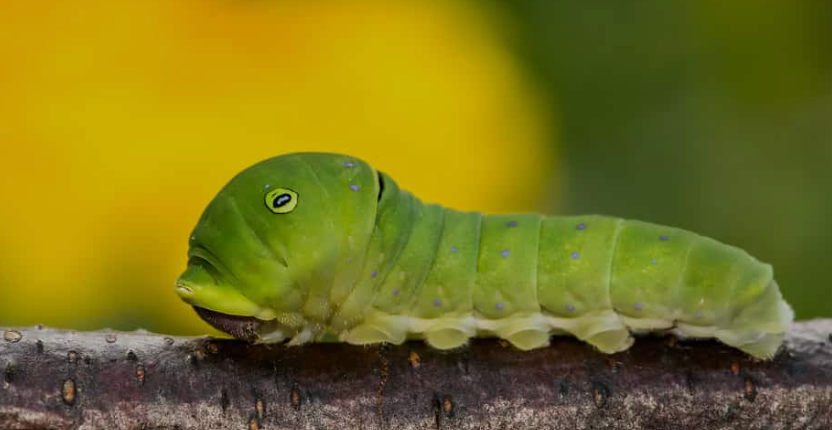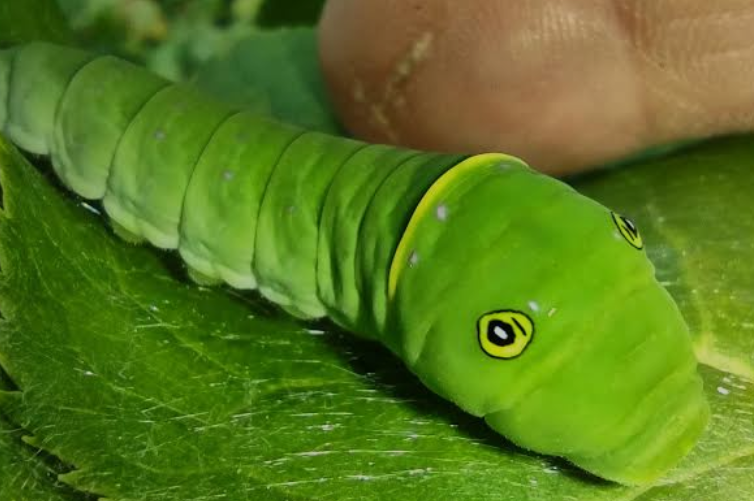
Classification
The Tiger Swallowtail Caterpillar belongs to the family Papilionidae, which includes swallowtail butterflies known for their large size, tail-like extensions on the hindwings, and vibrant colors. Its scientific name is Papilio glaucus. Like other Lepidoptera, it undergoes complete metamorphosis, progressing from egg to larva (caterpillar), pupa (chrysalis), and finally adult butterfly.
Identifying Characteristics
The caterpillar of the Tiger Swallowtail exhibits remarkable camouflage during its development. In early instars, it resembles bird droppings, a protective adaptation against predators. As it grows, it becomes bright green with large false eyespots on the thorax that mimic a snake, which deters birds and other predators. The body is smooth, cylindrical, and can reach up to 2 inches in length before pupation. Adults are equally striking, with yellow wings adorned with black tiger-like stripes, and males often have bright blue hindwing scales in some populations.
Distribution, Migration & Habitat
The Tiger Swallowtail is native to eastern North America, ranging from southern Canada to the Gulf of Mexico and parts of the Midwest. It is largely non-migratory, although individuals may disperse locally in search of suitable host plants or mating sites. Its preferred habitats include deciduous forests, river valleys, woodland edges, gardens, and suburban areas. Caterpillars are commonly found on host trees, while adults are frequently seen visiting flowering plants for nectar.
Predators & Threats
Despite their camouflage and defensive eyespots, Tiger Swallowtail caterpillars face predation from birds, parasitic wasps, and predatory insects. Adults are preyed upon by birds, spiders, and occasionally small mammals. Human activities such as habitat destruction, pesticide use, and urban development can reduce local populations. The caterpillar’s striking snake-like eyespots and early instar bird-dropping mimicry are key survival adaptations, but they do not guarantee protection against all threats.
Lifespan of Adults
Adult Tiger Swallowtail butterflies have a lifespan of about 2–3 weeks, depending on environmental conditions. During this time, their primary focus is reproduction and dispersal. Adults feed on nectar from a wide variety of flowering plants, which provides energy for flight and mating activities. Males actively patrol territories to find females, while females search for suitable host plants on which to lay eggs.
Host Plants & Diet
Tiger Swallowtail caterpillars are herbivorous and feed primarily on the leaves of deciduous trees. Common host plants include wild cherry (Prunus spp.), tulip tree (Liriodendron tulipifera), ash (Fraxinus spp.), birch (Betula spp.), and occasionally magnolia and other species. The caterpillars consume foliage voraciously during their growth stages to build energy reserves for pupation. Adult butterflies feed exclusively on nectar, using their long proboscis to extract it from flowers.
Life Cycle of Tiger Swallowtail Caterpillar (Papilio glaucus)

Egg Stage
The life cycle begins when adult female Tiger Swallowtails lay small, spherical eggs singly on the leaves or stems of host plants, such as wild cherry, tulip tree, ash, or birch. The eggs are pale green to yellow when first laid and darken slightly as they mature. Incubation lasts about 4–10 days, depending on temperature and environmental conditions, before the larvae hatch. This careful selection of host plants ensures the newly emerged caterpillars have immediate access to suitable food.
Larval Stage (Caterpillar)
Upon hatching, the larvae are tiny and initially resemble bird droppings, a camouflage adaptation that helps protect them from predators. As the caterpillars molt and grow through successive instars, they transform into bright green caterpillars with prominent false eyespots on the thorax, mimicking a snake to deter birds and other predators.
The larvae feed voraciously on the foliage of their host trees, growing to about 2 inches in length. The larval stage typically lasts three to four weeks, during which the caterpillar undergoes several molts to accommodate its rapidly increasing size.
Pupal Stage (Chrysalis)
When fully grown, the caterpillar attaches itself to a stem, twig, or other structure and forms a chrysalis. This pupal stage is a period of profound transformation, during which the caterpillar’s tissues are broken down and reorganized into the adult butterfly form.
Depending on the season, the pupal stage may last about 10–14 days in the summer, or the chrysalis may overwinter, with the adult emerging the following spring. The chrysalis is often green or brown, providing camouflage against predators.
Adult Stage (Butterfly)
The adult Tiger Swallowtail emerges from the chrysalis with large, yellow wings adorned with black tiger-like stripes and distinctive tails on the hindwings. Males and females can differ slightly in coloration, with females sometimes displaying more blue on the hindwings.
Adults live for about 2–3 weeks, feeding primarily on nectar from a variety of flowering plants. Their main purpose during this stage is reproduction: males patrol territories to locate females, and females lay eggs on suitable host plants to begin the next generation. After mating and egg-laying, adults die, completing the species’ life cycle.